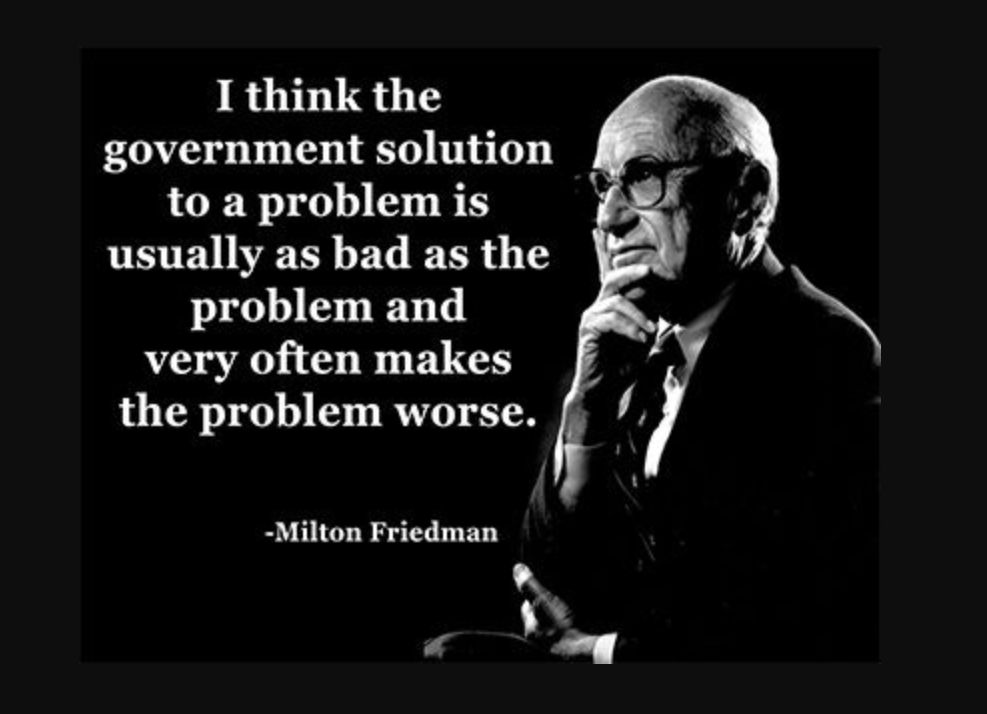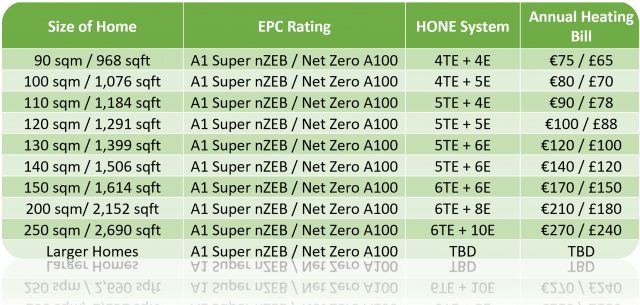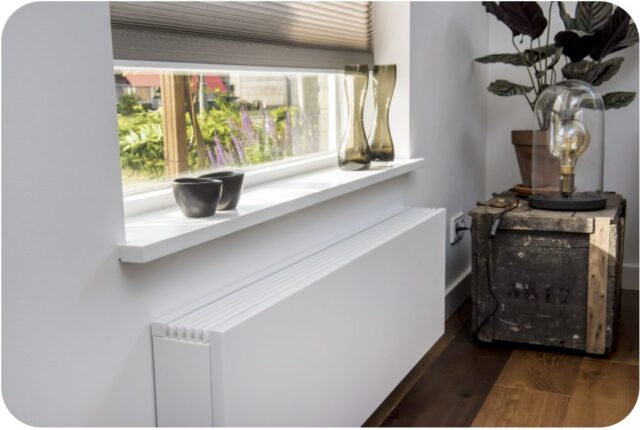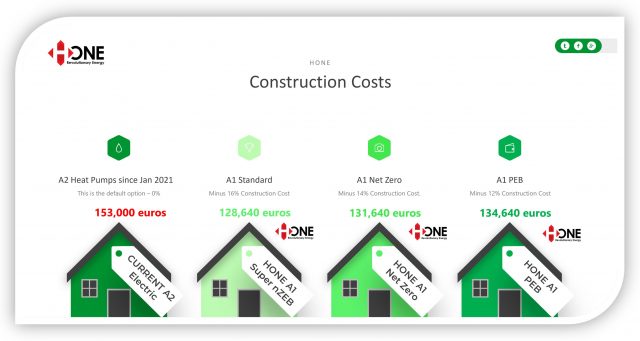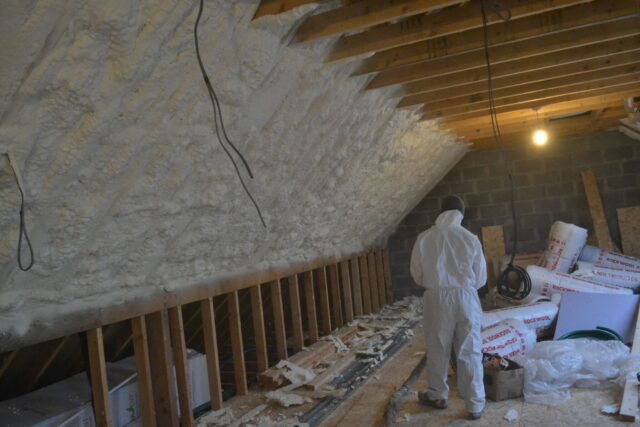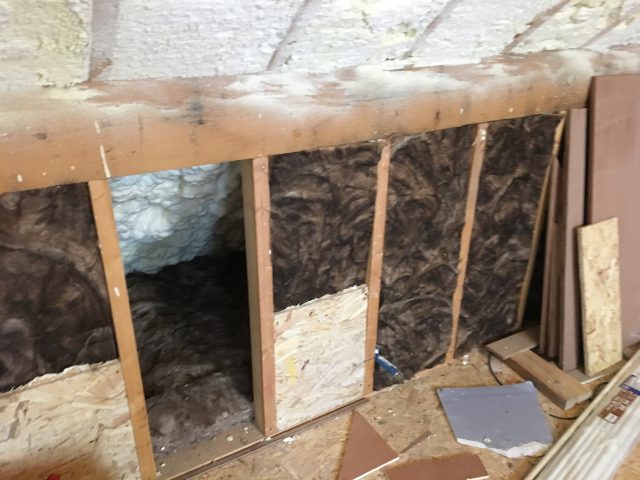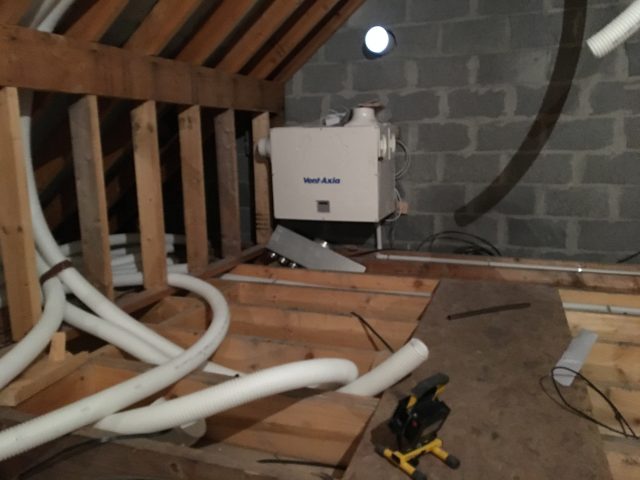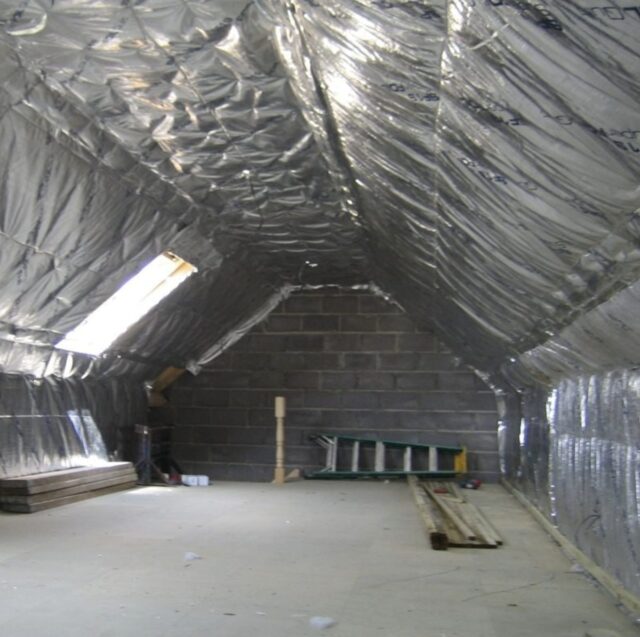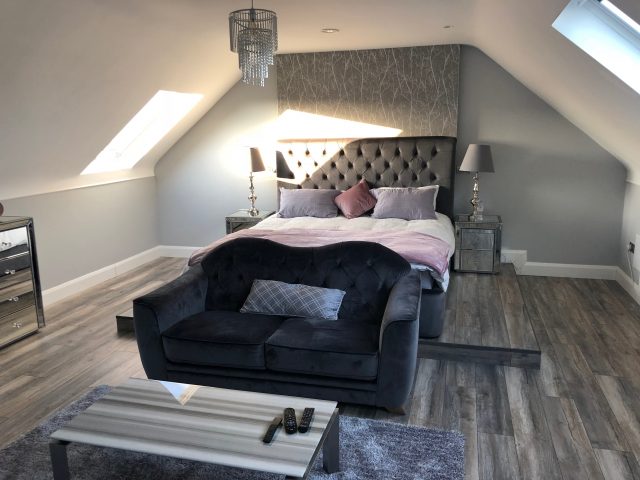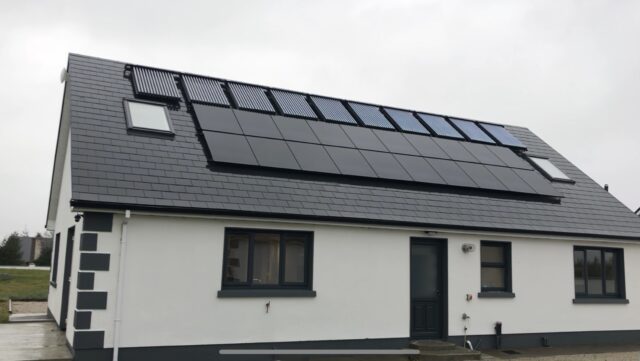Top 17 questions
On December 15th 2021, the EU published the new 2030 building standard, which means nZEB will be discontinued from 2030 onwards and “ZE – Zero Emissions” will be the new standard. New or existing buildings will have to meet Zero Emissions from 2030, and any building or home which does not meet this will have to be renovated from 2030 onwards.
This is a complete sea change from Europe, switching from near Zero Energy to Zero Emissions and a maximum of energy consumption of 60 kWh/m2 for residential and 70 kWh/m2 for commercial buildings. The EU has stepped in to make this significant change because studies have shown the EU will only meet 50% of the carbon reduction target unless some drastic action is taken.
It will see significant changes such as A Ratings solely reserved for Zero Emissions homes & buildings. This potentially could be a big disappointment to millions of buildings currently with an A-Rating in the EU who will move back to a B rating or worse from 2030 if they don’t meet ZE.
It also means if you are building a brand new home or other building to meet nZEB today, you most likely will have to renovate it to meet Zero Emissions at a future date and in the meantime, you can expect lots of carbon taxes to motivate you.
The good news is we can make your building fully compliant with the 2030 changes today, and you won’t have to retrofit your building in the future.
There is little point in building a new home or commercial building that will not meet this future standard. Avoid future taxes, penalties and a possible large renovation bill by getting it correct today. If a new build project, then this is especially easy to achieve with HONE and with a retrofit, we can easily deliver those solutions also.
As 80% of all building emissions in the EU are from heating, hot water & cooling, you need a powerful thermal/electric technology to meet your building needs.
You can read the summary of the changes below:
UK – Whilst we also do design for UK SAP, the future building standard is still a Work In Progress and SAP 10 if released as currently designed, will significantly change the primary energy value of home-generated renewable electricity in a major negative way to construction.
Nonetheless, we can still design Net Zero configurations in SAP 2012 and future proof them to SAP 10.
Our mission is simple.
We see the democratisation of energy as a human right.
For 140 years, prominent industry players and Governments have harvested Trillions of dollars/euros/pounds in profits and taxation by renting energy to everybody in a highly inefficient and wasteful method. See where it all started, https://en.wikipedia.org/wiki/John_D._Rockefeller (opens new page)
We buy our homes because we see rent as dead money, so why should we be forced to rent our energy.
Imagine a typical detached house with two cars that travel 8,500 miles (13,600kms) per year, a standard heating bill and an Electricity bill of €100 a month. You will spend over €450,059 (indexed @ 3% inflation annually) on renting your energy over the lifetime of a 30-year mortgage, excluding all maintenance, replacements, etc.
Over 50 years, you will have spent €942,875 (indexed @3% inflation annually) renting your energy. If your house is more significant than a typical 1,400 sqft home, and your bills are even more significant, then you can see how much money you are wasting on renting your energy.
Imagine how much this annual cost will become with future energy price increases, if not shortages.
Until recently, it wasn’t easy to choose anything other than buying all your energy from an energy supply company. However, this has changed; the technology is here, is being deployed, and HONE can deliver every facet of those solutions (and already have).
Investing in your energy systems is a no brainer; all the energy will be free, but don’t rush into it; get a properly designed solution. Any solution will be with you for decades, and that’s a long time to live with a rushed decision or poorly designed outcome.
Please be assured that this solution won’t arrive in your kitchen wearing a suit looking for you to write a cheque on the day. !!
We ship systems all over the world.
We can ship fully designed individual solutions for individual projects or large scale panel shipments from our manufacturing site to existing or new distribution partners.
Contact us to see about adding our solutions to your distribution.
We can also arrange system design and supply to dedicated installers, construction companies and similar anywhere in the world.
Thousands of HONE systems are installed in over 25 countries, from Canada to New Zealand, growing each day.
These range from new and retrofit residential projects, commercial projects like Hotels & Leisure centres to large scale Government commercial projects such as Hospitals and Municipal Leisure centres, with customers like the UK Government NHS and Dutch Municipal Government as examples.
HONE also powers Ireland’s & Europe’s best Government Energy Rated home, a retrofit project, which has zero energy bills and charges four electric cars for free.
This home has the first private grid in Ireland, which has been very common in other countries since the early 1900s. And it is something that will become very common as people opt for a private grid over the public grid and stop renting their energy as it is dead money, just like renting a house.
(This may be the world’s best energy rated home, but only that data is available in the EU for now)
As of 2021, over 1.8 billion people live off-grid or on private grids worldwide and this number is growing each year.
Typically, no specialist training is needed. You follow the instruction manuals with pictures and diagrams with our assistance.
You can come to our European training centre in Ireland, international flights direct to the door. We can do online remote training and support. More complex energy systems will need initial software configuration, which can be done online as well. We treat this on a case by case basis.
The installation of these technologies is pretty standard practice these days if you install heat pumps, solar hot water or solar PV. HONE systems are slightly simpler to install than legacy systems with fewer parts as they are all high-end plug and play where possible and full monitoring packages are included.
Otherwise, this is standard mechanical and electrical works.
In a new build project, the existing plumbing & electrical trades install as part of their overall installation; no specialist installers are needed, and the training options are available for them also. We would place technical support on-site during commencement works for more significant developments.
In residential, follow the standard install protocols, and in commercial systems, there will be a design process as those installations are usually a little more bespoke. Typically, there is interaction with us during the design process on every type of project.
You can always contact us for support before, during and after an installation.
Contact us, and we will help you design the correct option for your exact needs.
You can start by looking at the information below.
Then check out the case studies and look for the technical case study examples with EPC/BER data. There are residential and commercial examples.
If someone tries to sell you a one size fits all solution, it clearly won’t be designed for your situation but created so a salesperson can sell you something quickly without you complicating the sale.
If you are being offered a system without it being tested with a “provisional” energy rating (BER/SAP), then you could be wasting all your money. You should be told in advance what your “new” BER/SAP rating will be before you invest any money.
Take your time, no rush, it’s a big decision; get it right and invest your money wisely.
These technologies will be part of your life for decades into the future, so essential to get a solution roadmap adequately designed.
Note: As of 2030, a government renovation passport will be required under the new Energy Performance of Buildings Directive to show how to get each building to Zero Emissions, including all current new buildings, if they continue to be built to an nZEB standard from now until 2030.
Larger residential (developments) are the same as a one-off new build; it’s all about compliance and cost management. HONE delivers the lowest construction cost and exceeds either nZEB or Net Zero compliance, including meeting the new 2030 EU EPBD compliance from today.
NOTE: If you continue to build to nZEB only compliance from 2022, you will fall into the new EU renovation passport process and have to renovate the building to meet “Zero Emissions” from 2030. You will lose your buildings A-Rating from 2030 also.
We can demonstrate that reasonably quickly from our design & compliance process.
Larger commercial systems or non-residential projects will need scoping out, which we will do with you.
Contact us directly on these projects to conduct a desktop review.
Whilst we are a manufacturer and primarily supply distribution and other market partners, we actually own our own distribution companies in the UK & Ireland and, as such, have a different level of market support in those markets.
Yes, we do.
We also work closely with partners of all types, including delivering the supply chain and checking ongoing compliance before shipping against expected SAP and DEAP outcomes.
We can deliver construction savings of €250 per sqm for a HONE A1 Super nZEB versus A2 heat pump installs. The home will also have 80%-90% lower energy bills per year.
NOTE: For 2030 compliant “Zero Emissions” homes, we can deliver typical savings of €200 per sqm for a HONE A1 Zero Emissions home.
Send us your provisional DEAP/SAP information for each type, and we will model it for you. See further down this page for details on how to engage with us.
Absolutely.
You have just described what we do best.
See the case studies for an example of this very situation.
It’s straightforward.
We will need heating, hot water, electricity, and EV charging in our future buildings. As temperatures get milder and summers get hotter, we will need cooling in places it was never required traditionally. That adds up to a lot of annual energy, and it is getting more expensive each year.
HONE systems make free energy onsite, and that energy is both Heat & Power. One sqm of HONE Thermal Electric panel makes seven times the energy of one sqm of Solar PV, requiring only 14% of the roof space in comparison. We produce that energy from daylight, not sunlight. This means we are pumping lots of free energy into the building all year round. This also means the HONE system produces 100% free clean, renewable energy for your benefit.
With a heat pump, you must purchase the most expensive and most polluting energy (electricity) to run it. You still have to buy all your hot water energy, electricity, and power to recharge 1, 2 or possibly more electric cars also. In effect, you still are buying ALL your building energy just like you always have. Where is the advantage to the householder? There isn’t one. The Government designed it as they need to collect taxes from you, which will ensure you have energy bills long into the future.
Two important things to note: firstly, some EVs can consume ten houses worth of electricity to recharge from empty. At the same time, mainstream EV’s can take seven homes cost of daily electricity consumption.
IMAGINE, energy was money (which technically it is). A heat pump is spending your money each month on heating & hot water. In addition, you still have to pay for your electricity consumption and any EV charging costs.
Now consider a HONE system that makes nothing other than lots of free money and keeps plodging it into your bank account, allowing you to withdraw it to spend it on whatever you wish.
There is a better way, make your own green clean energy instead of buying someone else’s.
The application of HONE in a project, whether a residential or commercial new build, is part of the engineering specification. Your Architect will design your building; they will not specify the technical elements to meet regulations or outcomes. In addition, when you use HONE systems in your new build, you only need to use backstop U values & double glazing, so construction costs are also much lower.
After you have plans completed and agreed upon, you need to get a “provisional energy rating” EPC (DEAP/BER/SAP, etc.) completed on the plans. This will determine what technical specifications you need to meet building regulations.
Each country has different regulations.
You send the provisional EPC calculation, SAP or DEAP (BER) to us, and this is the stage we get involved in residential.
A video in the following sections shows you what we need and how to interact with us.
With commercial projects, we get involved from the very beginning.
A system kit has all the material elements plus smaller parts—Mountings, Panels, Controls, Fittings, Thermal Kit, Electrical Kit, etc.
HONE Thermal systems operate at very high temperatures, so all the equipment is high performance and all the HONE electrical systems come with equivalent high-performance equipment.
A kit is designed to have everything your local merchant would not have in stock, so they are very comprehensive.
One major advantage of HONE systems is the premium standard of equipment, controls & communications. Our car chargers are multi current and can operate from 1 KW to 7.5 KW, all controlled by the system. Our Ev chargers talk directly to the electricity generation system and can do really smart interactions. Future upgrades can be added seamlessly. You have full app control & monitoring in real-time. Our inverters have anti-shading technology perfect for the built environment.
You always need to check equipment specifications to see if you are getting individual basic modules that don’t talk to each other. High-quality systems should perform enhanced services, provide the most detailed data, and monitor minute by minute, as these are decade-long investments.
This is our basic standard, the highest premium specifications available.
The answer is yes and no.
HONE Thermal and/or Thermal/Electric systems are very powerful, so they need to get this thermal energy out of the system efficiently.
Standard solar hot water cylinders have tiny solar heat transfer coils because traditional solar hot water panels are not that powerful, so they typically have approx. 0.8 sqm surface area in a 300L cylinder.
HONE cylinders have coils approx 3.8 sqm surface area in a HONE 300L cylinder, nearly 5 times bigger.
This ensures an efficient system.
So the answer is you can, but you will create a roadblock for all the energy that HONE can create if you use a basic solar hot water cylinder.
If you already have an existing cylinder, swapping it out is not a challenging task and recommended.
You can see full case studies on this in the case study section;
HONE Thermal Panels;
(search HONE or Photonomi in DEAP 4.x.x)
- Aperture 0.88 sqm
- n0 – 0.75
- a1 – 2.368
- a2 – 0.000
- Dedicated Solar Volume is 50% of the cylinder size (150L) in a HONE thermal system, and 300L is the standard cylinder size.
- Dimensions: 1.6 sqm – Thermal only Panel. ( 1.0M wide x 1.6M long )
HONE Thermal/Electric Panels;
Renewable Thermal Inputs
(search HONE or Photonomi in DEAP 4.x.x)
- Aperture 0.88 sqm
- n0 – 0.75
- a1 – 2.368
- a2 – 0.000
- Dedicated Solar Volume is 50% of the cylinder size (150L) in a HONE thermal system, and 300L is the standard cylinder size.
Renewable Electric Inputs
- 98-watt rating per Thermal/Electric panel entered in the normal way.
- Dimensions: 1.6 sqm – Thermal/Electric Panel. ( 1.0M wide x 1.6M long )
HONE Electric Panels;
- 230-watt rating per Electric only panel entered in the normal way.
- Dimensions: 1.3 sqm – Electric only Panel. ( 1.3M x 1.0M )
NOTE: Whilst the 230w panel is our default residential and small commercial panel and is suitable for class 1 wind locations such as Ireland and Scotland, we can manufacture panels of any size for commercial projects in class 2, class 3 or class 4 wind locations.
Republic of Ireland NOTE: HONE Systems that fall under the category of Solar Central Heating systems have a bonus Appendix Q kWh calculation that must be done outside of DEAP 4.x.x in an excel spreadsheet and then entered into DEAP manually into the renewable heating additional energy section. Please ask for details as few BER Assessors are familiar with this process.
Ireland specific EPC only…
This section is relevant to DEAP if you are installing a renewable central heating system using HONE in a residential project;
This is a joint renewable thermal heating AND hot water system designed to feed your radiators or underfloor, typically in a retrofitting a home or new or existing commercial building.
In addition to entering all the data in the DEAP “solar hot water tab” as standard, you have to download the SEAI HONE spreadsheet below and enter the solar hot water tab data into the SEAI HONE Excel Spreadsheet linked below to create the additional thermal input into DEAP under Renewables > Thermal Input as in the image below.
You can download the spreadsheet below, and it has been filled out with the following sample data to assist you:
- HONE Array – 17.2 sqm
- Buffer Tank – 500L
- HONE Dedicated Volume – 250L
Large-scale renewable projects are absolutely driven solely by cost, so the cheaper, the better, and we all know there are no cheap Rolls Royces.
They also have large tracts of land and don’t have to deliver power across the year or any given time. Each year, it’s a simple model; they produce an amount of power and get paid an agreed price.
Buildings, on the other hand, are completely different. They need energy throughout the whole year, especially in winter. They need that energy to be available when there are energy requirements to fulfil, whether heat or electricity.
Buildings also have constraints in that they have limited space, or the roofs face the wrong direction, so they need the most powerful technologies.
This is why you see such variances in the performance from renewables, especially renewable electricity, where there is no certified annual kWh performance test.
This generally shocks people.
Unlike Solar Thermal technologies certified to produce a certain annual performance in kWhrs per year, there are no such tests for Solar PV panels.
This means if you installed a 3 KW Solar PV system from several different manufacturers, you would have seven different performance levels, so the rule is to get some evidence of data; there are a lot of cheap renewables out there. If you buy cheap, expect lower performance, the renewable industry is no different from any other industry.
Always apply the GOOD-FAST-CHEAP rules when deciding on your renewable route:
- GOOD and CHEAP won’t be FAST
- FAST and GOOD won’t be CHEAP
- CHEAP and FAST won’t be GOOD
ALWAYS ask to see historical performance data, especially in winter; it is your only assurance you are not being sold a panel you really don’t want or isn’t what you think, as your distributor or supplier may not actually know which panel type they are handling, just as much as you don’t.


New Build Residential
There is no limit to how far you can go.
1.8 Billion people live off-grid globally, and this is now becoming a thing in Europe due to two things, 1/ rising energy costs and risks to supply and 2/ its easy to do.
If you want a 100 MW renewable heating & electricity system to run your garden shed, we can design that system for you in any country in the world.
Don’t forget, Ireland’s number 1 energy rated home is a renovated #bungulowbliss home with a HONE private grid and a HONE Thermal central heating & hot water system.
See the electricity data below (thermal data separate) for Ireland’s best energy rated home with a private grid showing 17,093 kWh consumed, which at 50% avoided electricity purchasing and 50% going to charge EV’s was a saving of a staggering €8,203 in just one year’s electricity savings. (the thermal savings are not included and are a separate saving)
Watch the video below…
Please read the information in all these sections before going to case studies; it will help.
The best case study is your own. That’s why we will model your exact home, whether new or existing, for a detailed solution that fits your needs and goals. This will 1/ give you a pathway/roadmap to Zero Emissions and 2/ target your investment to where it matters.
We WILL NOT offer you a generic product or package, and we don’t employ salespeople. Our customers predominantly come by referral.
We offer this service free of charge with no obligation.
Whilst this example is from Ireland, it equally applies in the UK or any other country.
Here is the actual data from a detached house in Dublin, names and location removed.
It shows the QS analysis that the home was €175 per sqm cheaper to construct. The annual heating bill will be €230 as verified by SEAI DEAP software.
The outcome is not a basic A2 nZEB but an A1 Zero Emissions. This means the home produces the same amount of energy as it consumes. The house will be worth 20% more in value.
Unlike the heat pump option, where you still have to purchase 100% of your heating, hot water & electricity, the HONE option produces up to 90% of your annual hot water needs, 100% of your electricity with over 22,000 km of free EV charging per year if that suits your lifestyle.
As the HONE system has a design life of 50 years, you would have bought 4 heat pumps in that timeframe, 1 new one and 3 replacements.
Download the financial analysis here. QS-GAP-ANALYSIS-v3.0
Read the SEAI DEAP Dwelling Report here.
Read the SEAI DEAP Part L Report here.
The primary difference between A1 “ZE” Zero Emissions and A2 “nZEB” is lower overall energy consumption and yearly emissions. The new 2030 EU Building Standard makes nZEB obsolete in favour of “ZE” Zero Emissions buildings. HONE can give you the 2030 EU specification today, thus avoiding retrofitting your home after 2030.
Meeting A1 “ZE” Zero Emissions is easy using HONE systems, and the cost of building your home is lower than with a heat pump which would only achieve an A2 nZEB. (Note: It is not possible to meet ZE with a Heat Pump)
Also, your property will have a higher valuation, and if you are building a housing development, your homes will sell for higher prices.
The better the rating, the lower your bills, future carbon taxes, and the property’s more desirable.
So, where does this extra value come from? It comes from depriving the utilities & government of thousands in income and taxes over the next decades while living in your home or commercial building.
Please note: NET Zero Emissions and Zero Emissions are NOT the same.
This list is of typical HONE system configurations in new build homes where homeowners want to meet the ultimate low-cost home.
Please note that when you send us your energy rating information, we will confirm the Governments determination of what your new electric/heating & hot water bills will be and which HONE system will achieve them.
A HONE Drive system is a renewable electricity system coupled with a smart car charger. This may be part of an overall HONE Thermal/Electric residential or commercial system for heating, hot water & power.
However, there are critical design considerations for drive systems. Making your free electricity for EV charging is worth 70c/kWh (62p) in avoided petrol/diesel purchasing.
To use an example for the explanation, let’s say you install a 6 KW basic grid-connected system on your home, typically the largest basic grid-connected system you are allowed to install. It will operate during the day only, and whatever energy you don’t use will be spilt for free or sold to the grid for a low price. Your electric cars may be at work during the day, and you are producing no power when you get home.
However, you could put a battery system on that 6 KW system, but your average daily generation is still only 14 kWh per day. Still, your home will at least use 10 kWh per day on average electricity consumption, so you are left with an average of 3 kWh spare. That would leave you 16 km a day on average.
The good news is that HONE systems are not restricted in size; we can put any size installation on your home or business. Our drive systems can match your EV driving, even if that is 1, 2, 3 or 50 vehicles. At 70c per kWh, you need to make this element a crucial part of the design as it impacts payback, but only if the systems are big enough.
Basic grid-connected renewable electricity systems between 1KW & 6KW are too small for a future with electricity everything. The future is private grid systems that are not limited by size, and you can charge unlimited EV’s every day, even during hours of darkness.
Batteries make sense in larger installations, and you can even charge multiple EV’s at night with your free electricity.
Installing a battery needs careful design considerations. You may buy a low-performance battery that won’t last long or miss essential smart meter functions, such as the ability to download cheap night-rate electricity. Import Export real-time data and historical data is also vital. You get what you pay for when it comes to batteries.
All battery systems used in HONE projects are state-of-the-art with 8,000 cycles and 100% depth of discharge, giving them the most extended life window of approx 22 years if completely cycled 100% every day but typically above 50 years when cycled at 45%.
If you buy a cheap battery, it will have lower quality material, lower cycle count and depth of discharge. It will expire quicker. Like every industry, you don’t get premium solutions for low prices.
An intelligent decision with HONE electricity systems is to make it battery ready at installation time, and this is accomplished by adding an import/export meter option. This means your project is battery prepared from day one without rewiring.
Another critical feature of HONE systems is that all the units, inverters, batteries, car chargers, meters, etc., all talk to each other on a single app, even if you decide to add or modify the system in the future.
A private grid will have a professional battery system, and the size will depend on the project requirements.
It would be best to consider some intelligent panel heaters that can be run from your free electricity during the day at different times of the year.
Make sure you plug them into a socket using a three-pin plug and not a spur. The spur would mean they are included in your energy rating as a secondary heat source using electricity, negatively impacting your energy rating. Using three-pin plugs will be classed as occasional heaters and exempt from your energy rating.
For example, electricity in Ireland typically has three times more CO2 emissions than Kerosene.
Note the heater below modulates; this means it does not draw power all the time; it switches on and off and is very efficient. It has a 50% duty cycle, giving heat 100% of the time and only draws power 50% of the time, making it very efficient. When your HONE system is making free electricity during the day, it will be going into these heaters.
If you choose heaters such as infrared or standard fan heaters, these typically draw power constantly and should be avoided.
The heater below has its own time and temperature control managed from an app on your phone.
With HONE systems, renewable electricity or heating/cooling, we can supply “any size system” anywhere.
If you want a 100 MW renewable electricity system on your home or business, then no problem; we can design anything.
This is a speciality engineering area for us.
So if you fancy making your home or business entirely or partially off-grid / private grid, with no bills forever, then talk to us about a design no matter what country you are located in.
We can give you a solution roadmap that will allow you to build up an extensive system over several years.
The primary difference between HONE and a Heat Pump option is as follows:
- HONE makes free clean, renewable heat & electricity energy, thereby significantly lowering your energy bills. In contrast, a Heat Pump consumes grid electricity, so you are still buying 100% of your energy for heating, hot water & electricity (& EV Charging).
- HONE lowers your construction cost, typically by €250 a sqm.
- HONE speeds up your practical completion (typically 2 weeks faster).
- HONE increases the energy rating to an A1 “ZE” Zero Emissions or even better.
- HONE has practically zero OPEX maintenance requirements versus Heat Pumps with significant maintenance costs (Heat Pumps come with a maintenance plan requiring homeowners to do daily and weekly checks & service engineers to do annual services). Download Heat Pump Maintenace Guide Here
- HONE does not use any harmful materials, unlike Heat Pumps, filled with hydrofluorocarbons (HFCs). Every 10 Kgs of these F-Gases that could leak would release 20 tonnes of CO2 equivalent into the atmosphere. According to BREEAM, a residential heat pump leaks 6% of toxic refrigerant gas a year. A common R410A heat pump refrigerant would equal over 2 Tonnes of Co2 equivalent per year or the equivalent of driving 14 673 km. To give you a benchmark, a modern home is responsible for 1.2 tonnes of CO2 per year.
- HONE is silent, unlike a Heat Pump. READ THIS STORY ABOUT NOISE
- Unlike a HONE system, you will need a backup heat source for times when your heat pump breaks down. When a heat pump loses some of its gas, or you forget the major annual service, the heat pump external unit in cold weather will start freezing up and start taking heat from your house to defrost the outside unit. It will also turn on the auxiliary immersions, thereby costing you lots of money whilst you still potentially have a cold house. If a part goes in your heat pump or is totally degassed, you could be without heat for many days until it is fixed.
- HONE does not require an expensive underfloor heating system (but you may want it, and that is no problem, we can work with that too).
- HONE does not require the expense and time-wasting of pouring a second screed (again, you’ll need it if you want underfloor, and that’s ok).
- HONE does not require the huge and expensive fan-assisted aluminium radiators that you need for a heat pump, see picture below).
- HONE has a 50-year design life; you will have purchased 4 new replacement Heat Pumps in that period.
- HONE can be deployed from the smallest terraced house to the largest apartment complex easily.
- HONE systems are modular and fully expandable.
- HONE does not require an enhanced electricity connection or three-phase, unlike a Heat Pump.
- HONE increases the sales value of the property significantly.
- HONE systems are 100% recyclable.
With a heat pump, you will have to purchase 100% of your heating, hot water & electricity; it is that simple.
With HONE, we will make a significant amount of your heat and electricity, reducing your bills by 80%-90% typically versus a heat pump in a HONE A1 “ZE” Zero Emissions home.
If you go further, you can virtually zero your annual energy bills.
HONE is also much cheaper to install.
HONE systems have a simple 5-year service requirement, typically €300 for fluid service. On the other hand, Heat Pumps have to be checked each day, week and an effective service usually costing €900 a year needs to be completed (SEAI Heat Pump Guide). If you don’t do these services to Heat Pumps, the efficiency of your heat pump will fall away as they leak 6% of their F-Gas each year (BREAM), and your electricity bills will increase.
In Ireland (UK), a HONE system meeting an A1 “ZE” Zero Emissions rating where your home is valued at 10% more will save you up to 19% of your construction cost.
If your construction cost is €300,000, we will save you €57,000 in construction costs with HONE as your energy platform.
You would save €48,000 in construction costs for a HONE home with a Net Zero rating. – NOTE, This building meets the new 2030 Zero Emissions regulations.
You would save €40,800 in construction costs for a HONE home with a PEB rating (Positive Energy Building) – NOTE, This building meets the new 2030 Zero Emissions regulations.
HONE can be deployed in significant developments like normal and multi-res apartment complexes using centralised thermal/electricity systems.
This significantly reduces the cost of meeting nZEB (or the new 2030 Zero Emissions compliance) and delivers exceptionally low energy bills for tenants.
The M&E cost per apartment is significantly reduced versus a heat pump, and the ongoing OPEX costs collapse in comparison.
This also increases the value of each unit due to the higher energy ratings achieved with HONE solutions.
The backup heat source in a newly built home for the small amount of heating needed when you have a HONE system can be anything.
Still, we typically recommend an intelligent electric radiator system and/or bioLPG bulk tank or micro kerosene boiler as the installation & servicing costs are low. bioLPG is already 100% renewable with zero carbon tax, and HVO is a vegetable oil replacement for kerosene that is 100% renewable and already available in the UK & Northern Ireland. All new oil boilers are HVO boilers.
You can have any of these systems. The advantage of the bioLPG is that you can make your own green electricity as well.
All solutions can meet the EU 2030 Zero Emissions standard and exceed the UK future build standard. These solutions carry a zero carbon tax.
The current use of gas and kerosene will be with us for years to come, and prices are set to drop as electricity is pushed as a dominant heat source by Government. On the 31st of December 2021, the EU announced plans to make both national gas & nuclear green energy sources.
However, new HVO biofuel replacements for kerosene are already for sale in the UK. Your boiler will need a simple upgrade, and all new oil boilers are already HVO boilers.
The viable options for meeting the 2030 Zero Emissions regulations are intelligent electric radiators or/and a bioLPG gas boiler or oil boiler using HVO coupled with HONE systems. These options are both the lowest installation cost and 100% carbon tax-free.
Gas boiler users have this green gas option, a 100% renewable gas available in a large tank format. Gas boiler owners can convert to Green Hydrogen Gas (H2) from 2025 onwards. All British gas boilers currently being installed are Hydrogen ready. This gas will be made from local renewable energy and water, the H2 in H2O.
There are many options coming that are cheaper, less costly to install.
And, yes, they will mean you have low energy bills, and this will mean Government lose significant amounts of taxation they are used to collecting from you once you are clever about how you design your future.
If you do nothing, you face a future of significant electricity bills; by 2022, we are already seeing electric heating, 2 x electric cars and your regular electricity consumption becoming a serious monthly bill making your mortgage pale in comparison.
Don’t forget the billions in capital investments spent enhancing the grid for heat pumps and electric cars, which will be charged to electricity users.
Act early, and you can avoid this future; let us help you plot a course away from this scenario.
Jan 2022: EU EPBD 2030 Update: Under the new regulations for 2030 announced on Dec 15th 2021, by the European Commission, doing nothing is no longer an option. Each EU Government has to prepare a mandatory renovation passport for every building, and they will all have to become Zero Emissions by 2050.
HONE solutions achieve the lowest carbon emissions over any other option available, and we can easily meet the new 2030 EU Zero Emissions standard.
HONE Thermal/Electric dual-energy panels have the worlds highest performance rating and, as such, the world’s best emissions reduction values.
HONE can easily deliver zero-carbon, net-zero carbon and 100% no carbon energy outcomes, which no other technology can achieve.
This is why HONE systems deliver the best Energy Ratings of any other alternative and why Europe’s & Ireland’s best energy rated home is powered by HONE Thermal/Electric Technology. (and it is a 2006 retrofit concrete block home)
Here are some secrets of doing your project even better:
- Add an MHRV extract duct inside your hot press. HONE thermal systems are very powerful, and the hot press/room the HONE cylinder is placed in can typically average 30C to 50C. By placing an extract duct (the same as your wet rooms), you will feed all this free heat into your MHRV system, and it will spread it around the house for free.
- Lay electric heating floor mats in the tiled bathrooms; these also have time/temperature control and controlled by your smart devices. When you want a luxurious experience, crank it up to 30C. If you operate it during the day when you are making your own free electrical energy, the tiles will hold the heat for up to 20 hours, so you get the benefit long into the night.
- Don’t mount your car charger on a wall outside a bedroom; they have a very slight hum, and the very quiet vibrations may be felt or heard inside the bedroom wall.
Retrofit Residential
Regardless of which type of energy you require HONE to deliver, you will have a leading performance with the highest certified outputs per sqm as a significant benefit.
This means you can deliver large amounts of renewable energy from winter to summer. In fact, the thermal performance of HONE can be higher in December & January than traditional solar thermal in summer.
As of Jan 2022: The EU has published the 2030 EPBD building standards and every existing home even if newly built this week will have to be retrofitted to meet the new benchmark of “ZE” Zero Emissions from 2030. We can help you achieve this ina planned way.
See the technical FAQ for the more detailed performance section.
We also publish performance data on our Twitter account – Click Here
Whilst a new build may be a straightforward project, a retrofit needs careful planning.
You want a solution for your whole house; this may involve windows, ventilation, energy, electric car charging.
There are so many options for retrofit, but they all fall under the banner of Heat, Power & Drive. These are the three energy costs/requirements you will have in the future.
Once you have an Energy Rating completed on your home, we can look at all the detail and best advise you from there.
Don’t forget renovations to homes now fall under “ZE” Zero Emissions from 2030 as published by the EU on the 15th December 2021. All buildings in the EU will have to be “ZE” Zero Emissions by 2050. All existing homes in Europe that are A-Rated will lose this rating from 2030 as it is exclusively reserved for homes that meet the new Zero Emissions compliance from that date.
As with a new build, you can have any energy rating outcome you want on a retrofit; tell us, and we will design a specification just for your home.
Don’t forget that Europe’s & Ireland’s best A1 energy rated home is a retrofit 2006 concrete home which was initially an E1 Energy Rated home. With some intelligent planning in the right places, it is now the exemplar retrofit project in Europe and will retain its A Rating as it meets the new 2030 ZE building standards.
(The European Commission funded the peer review of the data on this project)
There is no limit to how far you can go.
1.8 Billion people live off-grid globally, and this is now becoming a thing in Europe due to two things, 1/ rising energy costs and risks to supply and 2/ its easy to do.
If you want a 100 MW renewable heating & electricity system to run your garden shed, we can design that system for you in any country in the world.
Don’t forget, Ireland’s number 1 energy rated home is a renovated #bungulowbliss home with a HONE private grid and a HONE Thermal central heating & hot water system.
See the electricity data below (thermal data separate) for Ireland’s best energy rated home with a private grid showing 17,093 kWh consumed, which at 50% avoided electricity purchasing and 50% going to charge EV’s was a saving of a staggering €8,203 in just one year’s electricity savings. (the thermal savings are not included and are a separate saving)
Watch the video below…
Please read the information in all these sections before going to case studies; it will help.
The best case study is your own. That’s why we will model your exact home, whether new or existing, for a detailed solution that fits your needs and goals. This will 1/ give you a pathway/roadmap to Zero Emissions and 2/ target your investment to where it matters.
We WILL NOT offer you a generic product or package, and we don’t employ salespeople. Our customers predominantly come by referral.
We offer this service free of charge with no obligation.
A HONE Drive system is a renewable electricity system coupled with a smart car charger. This may be part of an overall HONE Thermal/Electric residential or commercial system for heating, hot water & power.
However, there are critical design considerations for drive systems. Making your free electricity for EV charging is worth 70c/kWh (62p) in avoided petrol/diesel purchasing.
To use an example for the explanation, let’s say you install a 6 KW basic grid-connected system on your home, typically the largest basic grid-connected system you are allowed to install. It will operate during the day only, and whatever energy you don’t use will be spilt for free or sold to the grid for a low price. Your electric cars may be at work during the day, and you are producing no power when you get home.
However, you could put a battery system on that 6 KW system, but your average daily generation is still only 14 kWh per day. Still, your home will at least use 10 kWh per day on average electricity consumption, so you are left with an average of 3 kWh spare. That would leave you 16 km a day on average.
The good news is that HONE systems are not restricted in size; we can put any size installation on your home or business. Our drive systems can match your EV driving, even if that is 1, 2, 3 or 50 vehicles. At 70c per kWh, you need to make this element a crucial part of the design as it impacts payback, but only if the systems are big enough.
Basic grid-connected renewable electricity systems between 1KW & 6KW are too small for a future with electricity everything. The future is private grid systems that are not limited by size, and you can charge unlimited EV’s every day, even during hours of darkness.
Batteries make sense in larger installations, and you can even charge multiple EV’s at night with your free electricity.
Installing a battery needs careful design considerations. You may buy a low-performance battery that won’t last long or miss essential smart meter functions, such as the ability to download cheap night-rate electricity. Import Export real-time data and historical data is also vital. You get what you pay for when it comes to batteries.
All battery systems used in HONE projects are state-of-the-art with 8,000 cycles and 100% depth of discharge, giving them the most extended life window of approx 22 years if completely cycled 100% every day but typically above 50 years when cycled at 45%.
If you buy a cheap battery, it will have lower quality material, lower cycle count and depth of discharge. It will expire quicker. Like every industry, you don’t get premium solutions for low prices.
An intelligent decision with HONE electricity systems is to make it battery ready at installation time, and this is accomplished by adding an import/export meter option. This means your project is battery prepared from day one without rewiring.
Another critical feature of HONE systems is that all the units, inverters, batteries, car chargers, meters, etc., all talk to each other on a single app, even if you decide to add or modify the system in the future.
A private grid will have a professional battery system, and the size will depend on the project requirements.
It would be best to consider some intelligent panel heaters that can be run from your free electricity during the day at different times of the year.
Make sure you plug them into a socket using a three-pin plug and not a spur. The spur would mean they are included in your energy rating as a secondary heat source using electricity, negatively impacting your energy rating. Using three-pin plugs will be classed as occasional heaters and exempt from your energy rating.
For example, electricity in Ireland typically has three times more CO2 emissions than Kerosene.
Note the heater below modulates; this means it does not draw power all the time; it switches on and off and is very efficient. It has a 50% duty cycle, giving heat 100% of the time and only draws power 50% of the time, making it very efficient. When your HONE system is making free electricity during the day, it will be going into these heaters.
If you choose heaters such as infrared or standard fan heaters, these typically draw power constantly and should be avoided.
The heater below has its own time and temperature control managed from an app on your phone.
With HONE systems, renewable electricity or heating/cooling, we can supply “any size system” anywhere.
If you want a 100 MW renewable electricity system on your home or business, then no problem; we can design anything.
This is a speciality engineering area for us.
So if you fancy making your home or business entirely or partially off-grid / private grid, with no bills forever, then talk to us about a design no matter what country you are located in.
We can give you a solution roadmap that will allow you to build up an extensive system over several years.
The primary difference between HONE and a Heat Pump option is as follows:
- HONE makes free clean, renewable heat & electricity energy, thereby significantly lowering your energy bills. In contrast, a Heat Pump consumes grid electricity, so you are still buying 100% of your energy for heating, hot water & electricity (& EV Charging).
- HONE lowers your construction cost, typically by €250 a sqm.
- HONE speeds up your practical completion (typically 2 weeks faster).
- HONE increases the energy rating to an A1 “ZE” Zero Emissions or even better.
- HONE has practically zero OPEX maintenance requirements versus Heat Pumps with significant maintenance costs (Heat Pumps come with a maintenance plan requiring homeowners to do daily and weekly checks & service engineers to do annual services). Download Heat Pump Maintenace Guide Here
- HONE does not use any harmful materials, unlike Heat Pumps, filled with hydrofluorocarbons (HFCs). Every 10 Kgs of these F-Gases that could leak would release 20 tonnes of CO2 equivalent into the atmosphere. According to BREEAM, a residential heat pump leaks 6% of toxic refrigerant gas a year. A common R410A heat pump refrigerant would equal over 2 Tonnes of Co2 equivalent per year or the equivalent of driving 14 673 km. To give you a benchmark, a modern home is responsible for 1.2 tonnes of CO2 per year.
- HONE is silent, unlike a Heat Pump. READ THIS STORY ABOUT NOISE
- Unlike a HONE system, you will need a backup heat source for times when your heat pump breaks down. When a heat pump loses some of its gas, or you forget the major annual service, the heat pump external unit in cold weather will start freezing up and start taking heat from your house to defrost the outside unit. It will also turn on the auxiliary immersions, thereby costing you lots of money whilst you still potentially have a cold house. If a part goes in your heat pump or is totally degassed, you could be without heat for many days until it is fixed.
- HONE does not require an expensive underfloor heating system (but you may want it, and that is no problem, we can work with that too).
- HONE does not require the expense and time-wasting of pouring a second screed (again, you’ll need it if you want underfloor, and that’s ok).
- HONE does not require the huge and expensive fan-assisted aluminium radiators that you need for a heat pump, see picture below).
- HONE has a 50-year design life; you will have purchased 4 new replacement Heat Pumps in that period.
- HONE can be deployed from the smallest terraced house to the largest apartment complex easily.
- HONE systems are modular and fully expandable.
- HONE does not require an enhanced electricity connection or three-phase, unlike a Heat Pump.
- HONE increases the sales value of the property significantly.
- HONE systems are 100% recyclable.
NOTE: Base Residential Electricity prices in Ireland have increased by 75% in the 2nd half of 2021 and now stand at a typical bi-monthly rental of €61 including PSO and 38.78c per kWh free of contract lock-in.
The UK sees the same price rises, but these have not been passed on to residential customers yet as the price cap in force in the UK will not be reviewed until April 2022, when eye-watering price increases are expected. (This is the reason so many energy suppliers in the UK went out of business in 2021)
With HVO, a 100% renewable fuel shortly to arrive, it makes no sense to spend thousands of euros/pounds on a heat pump that is more expensive to run than your existing oil boiler. Just change from kerosene to HVO, and you will avoid all carbon tax.
An insulation tea cosy is where you place insulation in your roof space/attic as if it was acting like a tea cosy.
It involves doing “insulation on rafter” in a certain way. You cannot do this with “insulation on the ceiling”. You insulate on Rafter, then make it airtight with a super quilt which is sealed down to the soffit. It is transformational in existing homes the level of comfort that comes with this approach. (please see our case study E1 to A2 nZEB where there more detail on this upgrade)
You make the upper roof segment airtight, making the attic hold a higher temperature than downstairs. This uses fundamental physics to stop the heat from rising from downstairs. This has a significant impact on the comfort of your house and your energy bills.
An example of this would be to foam your attic all the way down to the soffit (with rear ventilation behind the foam) and then use a product like Superquilt foil, which you can tape the joints and create an airtight structure.
This closes off heat loss for your attic. This insulation method is easy to do and is highly effective on retrofit homes, completely changing the heat loss. Couple this with an MHRV system, and you can install rigid pipes first and then foam them into place. Then, you close all the air vents downstairs, permanently seal them, and remove your chimney inside the roof tiles.
These measures alone will lower your heating bills by up to 70% in a retrofit home.
Then add in a HONE Heat, Power & Drive system, and you’ll go all the way to an A2 nZEB Retrofit with heating oil bills down to €300-€400 a year with most of your hot water and electricity made free on your roof.
With a heat pump, you will have to purchase 100% of your heating, hot water & electricity; it is that simple.
Heat Pumps are only suitable for houses with low heat loss and low heat requirements. Heat Pumps are not boilers, and they struggle to provide heat on cold days in brand new houses. In a retrofit home, you would have to spend thousands on the fabric of your home first so that you could then spend thousands more on buying a heat pump. Next comes the high electricity bills.
There is a more effortless and better way to invest your money in your home. This is why you can’t access the heat pump grant until you have invested (quote SEAI, potentially €40,000) in upgrading your fabric first.
With HONE, we will make a significant amount of your heat and electricity, typically reducing your bills by 80%-90% versus a heat pump in a HONE A1 “ZE” Zero Emissions home.
If you go further, you can virtually zero your annual energy bills.
HONE is also much cheaper to install.
HONE systems have a simple 5-year service requirement, typically €300 for fluid service. Heat Pumps have to be checked each day, week and a significant service costing typically €900 a year needs to be completed. If you don’t do these services to Heat Pumps, the efficiency of your heat pump will fall away, and your electricity bills will increase.
Retrofit homes would need significant fabric investments for heat pumps; SEAI quote potentially €40,000 of home fabric upgrades before you would be eligible to apply for a Heat Pump grant, which means the heat pump installation cost is in addition.
In addition, with a heat pump, you will only get to a B2 energy rating, and as of Jan 2022, the EU has stated this will not be acceptable as Zero Emissions is the new standard from 2030. You will still have to buy 100% of your heat, hot water & electricity.
HONE systems deliver 100% free renewable energy into the home, with significantly lower retrofit costs in comparison and can quickly get you an A1 “ZE” Zero Emissions rating even on a retrofit. You will also have 80%-90% lower annual energy bills versus a heat pump.
With a HONE solution, you can make most of your heat & electricity energy for free on your own roof.
Refurbishing a single house or a large development using HONE is very straightforward.
See our case study section for examples.
The backup heat source in a retrofit home with a HONE system can be anything, including your existing oil-fired heating system.
Still, we typically recommend an intelligent electric radiator system and/or bioLPG bulk tank or micro kerosene boiler as the installation & servicing costs are low. bioLPG is already 100% renewable with zero carbon tax, and HVO is a vegetable oil replacement for kerosene that is 100% renewable and already available in the UK & Northern Ireland. All new oil boilers are HVO boilers.
You can have any of these systems. The advantage of the bioLPG is that you can make your own green electricity as well.
All solutions can meet the EU 2030 Zero Emissions standard and exceed the UK future build standard. These solutions carry a zero carbon tax.
The current use of gas and kerosene will be with us for years to come, and prices are set to drop as electricity is pushed as a dominant heat source by Government. On the 31st of December 2021, the EU announced plans to make both national gas & nuclear green energy sources.
However, new biofuel replacements for kerosene and are in development already available in the UK. This will likely mean you re-jet your oil boiler and go green.
The only two viable options for meeting the 2030 Zero Emissions regulations are intelligent electric radiators or/and a bioLPG gas boiler coupled with HONE systems. These options are both the lowest installation cost and 100% carbon tax-free.
Gas boiler users have this green gas option, a 100% renewable gas available in a large tank format. Gas boiler owners will convert to Green Hydrogen Gas (H2) from 2025 onwards. All British gas boilers currently being installed are Hydrogen ready. This gas will be made from local renewable energy and water, the H2 in H2O.
There are many options coming that are cheaper, less costly to install.
And, yes, they will mean you have low energy bills, and this will mean Government lose significant amounts of taxation they are used to collecting from you once you are clever about how you design your future.
If you do nothing, you face a future of significant electricity bills; by 2022, we are already seeing electric heating, 2 x electric cars and your regular electricity consumption becoming a serious monthly bill making your mortgage pale in comparison.
Don’t forget the billions in capital investments spent enhancing the grid for heat pumps and electric cars, which will be charged to electricity users.
Act early, and you can avoid this future; let us help you plot a course away from this scenario.
Jan 2022: EU EPBD 2030 Update: Under the new regulations for 2030 announced on Dec 15th 2021, by the European Commission, doing nothing is no longer an option. Each EU Government has to prepare a mandatory renovation passport for every building, and they will all have to become Zero Emissions by 2050.
HONE solutions achieve the lowest carbon emissions over any other option available, and we can easily meet the new 2030 EU Zero Emissions standard.
HONE Thermal/Electric dual-energy panels have the worlds highest performance rating and, as such, the world’s best emissions reduction values.
HONE can easily deliver zero-carbon, net-zero carbon and 100% no carbon energy outcomes, which no other technology can achieve.
This is why HONE systems deliver the best Energy Ratings of any other alternative and why Europe’s & Ireland’s best energy rated home is powered by HONE Thermal/Electric Technology. (and it is a 2006 retrofit concrete block home)
Here are some secrets of doing your project even better:
- Add an MHRV extract duct inside your hot press. HONE thermal systems are very powerful, and the hot press/room the HONE cylinder is placed in can typically average 30C to 50C. By placing an extract duct (the same as your wet rooms), you will feed all this free heat into your MHRV system, and it will spread it around the house for free.
- Lay electric heating floor mats in the tiled bathrooms; these also have time/temperature control and controlled by your smart devices. When you want a luxurious experience, crank it up to 30C. If you operate it during the day when you are making your own free electrical energy, the tiles will hold the heat for up to 20 hours, so you get the benefit long into the night.
- Don’t mount your car charger on a wall outside a bedroom; they have a very slight hum, and the very quiet vibrations may be felt or heard inside the bedroom wall.
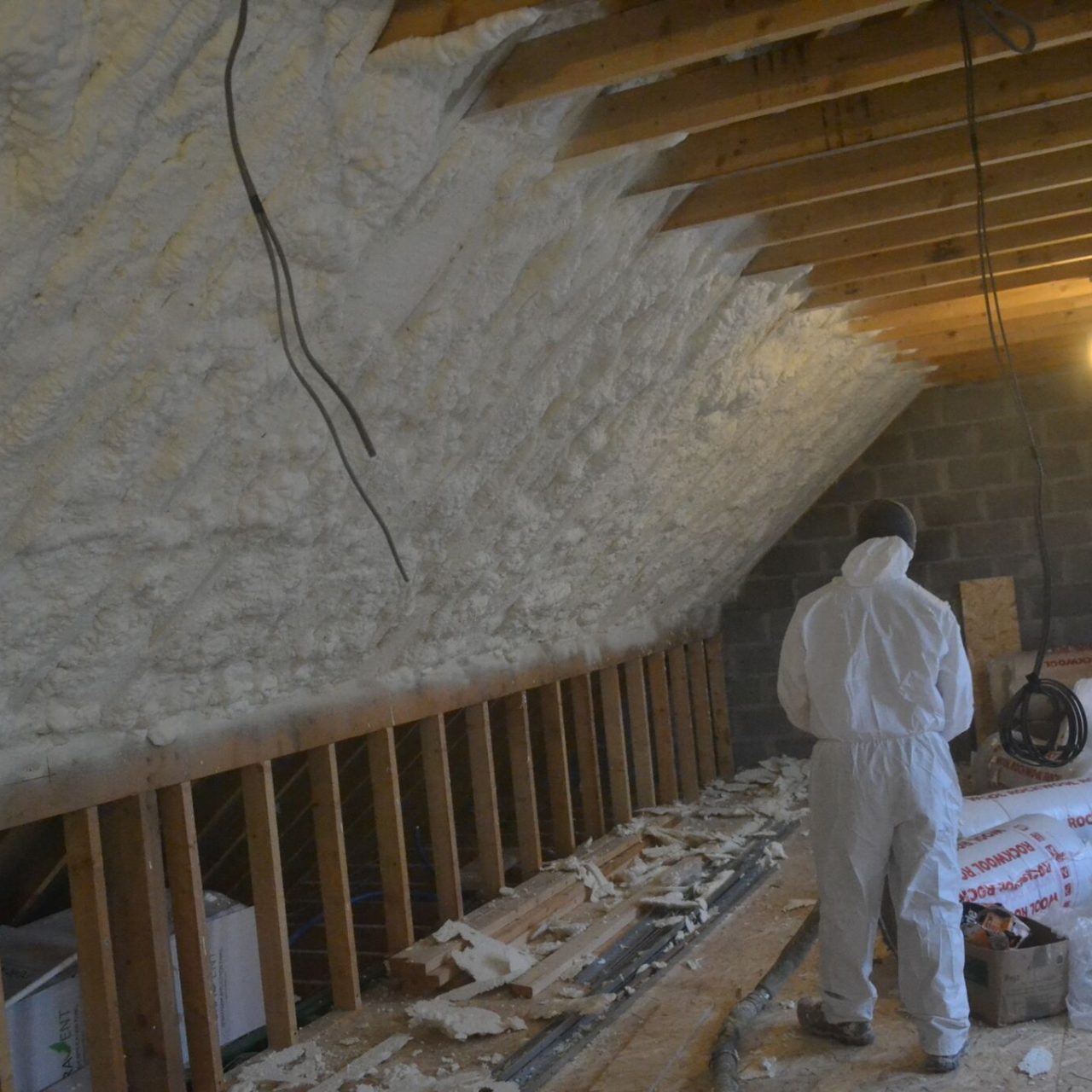
Subscribe to Our Newsletter
Subscribe to
Our Newsletter


